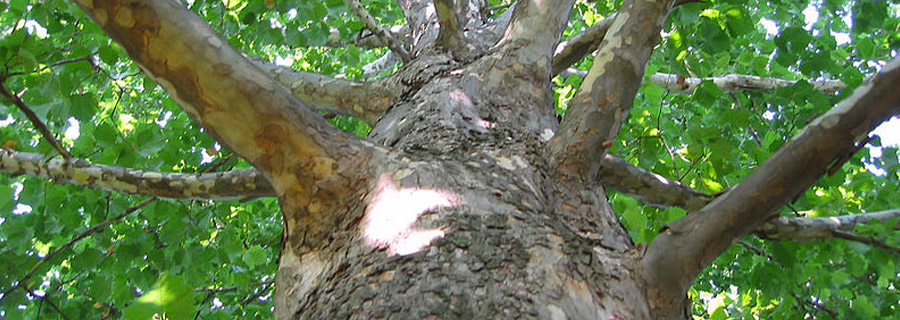When Should I Prune my Sycamore Tree?
Light pruning in June, heavy pruning between October & December
Expert insight into the best time to prune a sycamore tree; why sycamore tree pruning is important, and how to identify common sycamore tree diseases.
The sycamore tree belongs to the maple family. Of the Latin Acer pseudoplatanus, the sycamore is a large broadleaf deciduous tree that is native to southern, eastern and central parts of Europe. It is thought to have come to the United Kingdom during the Middle Ages, and is now considered a naturalised species, highly prevalent across the country due to the ability of its winged seeds to spread and reseed with ease.
The domed canopy of the sycamore tree is particularly striking, and the tree will grow to heights of up to 35 metres and can live more than 400 years. You’ll find it along avenues and in gardens and parks, creating much called for shade.


Why prune a sycamore tree?
The sycamore tree has a tendency to grow into an odd shape as it matures, often with drooping branches and extreme angles. Sometimes the branches will wrap around the tree. Pruning is essential to manage the tree’s shape, and it will also promote new growth.
Sycamore trees benefit from pollarding to keep them at an ideal height, particularly if they are growing along avenues and on public land. Pollarding also helps create a nicely rounded canopy, but this needs to start as a continuous process from the tree’s early days and then carry on every year for shape and size maintenance.
Sycamore pollarding or crown reduction is particularly useful when light is being blocked and there is the risk of neighbour disputes arising.
When is the best time for sycamore tree pruning?
Because sycamore sap is at its most prevalent during the spring, it is important to refrain from pruning this tree during this season as it could lead to fatal consequences. Bleeding sap attracts bugs, which bring with them disease.
If you are pruning a sycamore tree simply to remove unwanted branches, it is best to undertake the work in June. However, if you are looking to heavily prune the tree, you should leave it until later in the year, preferably between October and December. Proceed with caution though, because you need to avoid damaging the collars of the branches by keeping the pruning flush with them. Remember, open wounds are potential points of disease ingress, so all pruning should work to minimise this. If in doubt, consult a qualified tree surgeon.
You will also need to remove dead wood on a regular basis, and crown thinning is also a wise move so as to allow light and air to penetrate, which is vital for the prolonged health of the tree. Wherever possible, carry out this work during the month of June.
A tree surgeon will inspect the tree and work out whether certain limbs will be able to carry the weight of the leaves. If they aren’t, then they will remove them, because they will become unsafe and could stress the tree as a result.
What to look for during sycamore tree pruning
The sycamore tree is prone to sooty bark (cryptostroma corticale). Where the weather has been continuously hot, sooty bark will cause partial or total crown wilting which can eventually be fatal.
Verticillium wilt is a fungal disease that gets into the tree through the roots. It causes wilting, yellowing leaves and dieback. Phytophthora root rot causes yellow, sparse or wilting foliage together with branch dieback.
Leaf spot and tar spot are also common issues, although these aren’t considered too dangerous. Bark stripping by grey squirrels is another low key problem.
Pest wise, the horse chestnut scale insect is one of the main issues, although it doesn’t tend to affect the trees unless they have been deprived of nutrients or water. Look out for white circular egg masses partially covered by brown shells on trunks and larger branches. These will appear in early summer and are caused by a sap-sucking insect.
Tree Preservation Orders
You should never go ahead with any tree work, including sycamore tree pruning, before learning whether there is a Tree Preservation Order (TPO) in place. If so, you have to seek permission for the works. This will usually take up to eight weeks to materialise. Furthermore, if the tree is situated in a conservation area, permission must be obtained before starting works of any kind.
The importance of sycamore tree pruning expertise
The health and safety of your sycamore tree, and its overall appearance and attractiveness, is all down to the way you care for it.
Tree surgeons are trained to identify diseases and pest infestations and are fully aware of exactly how to best treat them. In addition, they are trained to know the best pruning methods and have the knowledge to advise you on the correct procedures so that you can make sure it benefits in every way.
If you have a sycamore tree that needs pruning, why not get in touch with T.H. Tree Services? As fully qualified and highly experienced tree surgeons, we are able to offer specialist expertise across all areas of sycamore tree pruning. For a free, no-obligation quotation, contact our friendly experts on 01268 642814 or get in touch here.
Amazing service from Mark and his team. We had a problem with Bamboo that had spread from a neighbours garden. Mark kept us informed with regular phone calls and images of how the work was progressing, as we were not present the house. 1st class job and a pleasure to do business with this company.
Thank you Colin and Gillian for your kind review. It was a pleasure to be able to clear the bamboo for you.







